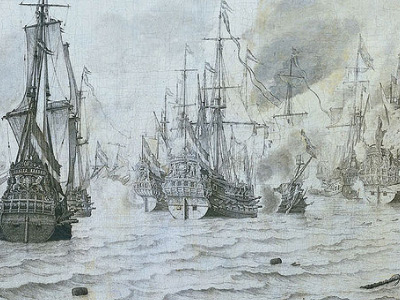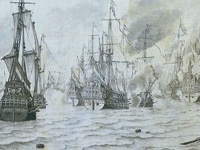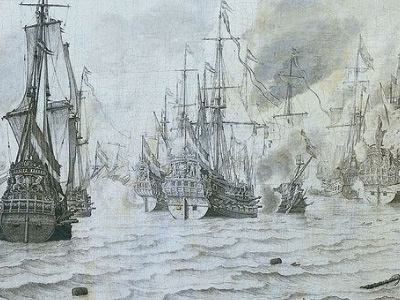Eighty Years' War (1568–1648)

The Republic Sallies Forth (1629–1635)
Meanwhile, the Imperial forces had surged in Germany after the initial setback from the intervention of Christian IV of Denmark in the war in 1625. Both the Danes and Mansfelt were defeated in 1626, and the Catholic League occupied the northern German lands that had hitherto acted as a buffer zone for the Republic. For a while in 1628 an invasion of the eastern part of the Republic seemed imminent. However, the relative might of Spain The Spanish Empire was a colonial empire governed by Spain and its predecessor states between 1492 and 1976. One of the largest empires in history, it was the first to usher the European Age of Discovery and achieve a global scale, controlling vast territory. It was one of the most powerful empires of the early modern period, reaching its maximum extent in the 18th century., the main player up to now in the German civil war, was ebbing fast. By April 1629 the States Army counted 77,000 soldiers, half as much again as the Army of Flanders at that point in time. This allowed Frederick Henry to raise a mobile army of 28,000 (the other troops were used in the fixed garrisons of the Republic) and invest 's-Hertogenbosch. During the siege of this strategic fortress city the imperialist and Spanish allies launched a diversionary attack from Germany's IJssel line. After crossing this river, they invaded the Dutch heartland, getting as far as the city of Amersfoort, which promptly surrendered. The States General, however, mobilised civic militias and scrounged garrison troops from fortresses all around the country, assembling an army that at the height of the emergency numbered no less than 128,000 troops. This enabled Frederick Henry to maintain his siege of 's-Hertogenbosch. When Dutch troops surprised the Spanish fortress of Wesel, which acted as the principal Spanish supply base, this forced the invaders to retreat to the IJssel. 's-Hertogenbosch surrendered in September 1629 to Frederick Henry.
The Spanish Empire was a colonial empire governed by Spain and its predecessor states between 1492 and 1976. One of the largest empires in history, it was the first to usher the European Age of Discovery and achieve a global scale, controlling vast territory. It was one of the most powerful empires of the early modern period, reaching its maximum extent in the 18th century., the main player up to now in the German civil war, was ebbing fast. By April 1629 the States Army counted 77,000 soldiers, half as much again as the Army of Flanders at that point in time. This allowed Frederick Henry to raise a mobile army of 28,000 (the other troops were used in the fixed garrisons of the Republic) and invest 's-Hertogenbosch. During the siege of this strategic fortress city the imperialist and Spanish allies launched a diversionary attack from Germany's IJssel line. After crossing this river, they invaded the Dutch heartland, getting as far as the city of Amersfoort, which promptly surrendered. The States General, however, mobilised civic militias and scrounged garrison troops from fortresses all around the country, assembling an army that at the height of the emergency numbered no less than 128,000 troops. This enabled Frederick Henry to maintain his siege of 's-Hertogenbosch. When Dutch troops surprised the Spanish fortress of Wesel, which acted as the principal Spanish supply base, this forced the invaders to retreat to the IJssel. 's-Hertogenbosch surrendered in September 1629 to Frederick Henry.
The loss of Wesel and 's-Hertogenbosch (a city that had been fortified according to the most modern standards, often incorporating Dutch innovations in fortification), in short succession, caused a sensation in Europe. It demonstrated that the Dutch, for the moment, enjoyed strategic superiority. 's-Hertogenbosch was the linchpin of the ring of Spanish fortifications in Brabant; its loss left a gaping hole in the Spanish front. Thoroughly shaken, Philip IV now overruled Olivares and offered an unconditional truce. The States General refused to consider this offer until the Imperial forces had left Dutch territory. Only after this had been accomplished did they remit the Spanish offer to the States of the provinces for consideration. The popular debate that followed split the provinces. Friesland, Groningen and Zeeland, predictably, rejected the proposal. Frederick Henry appears to have favoured it personally, but he was hampered by the political divisions in the province of Holland where radical Counter-Remonstrants and moderates were unable to agree. The Counter-Remonstrants urged in guarded terms a final eradication of "Remonstrant" tendencies in the Republic (thus establishing internal "unity") before a truce could even be considered. The radical Calvinist preachers urged a "liberation" of more of the Spanish Netherlands. Shareholders in the WIC dreaded the prospect of a truce in the Americas, which would thwart the plans of that company to stage an invasion of Portuguese Brazil. The peace party and the war party in the States of Holland therefore perfectly balanced each other and deadlock ensued. Nothing was decided during 1629 and 1630.
To break the deadlock in the States of Holland, Frederick Henry planned a sensational offensive in 1631. He intended to invade Flanders and make a deep thrust toward Dunkirk, like his brother had done in 1600. His expedition was even larger. He embarked 30,000 men and 80 field guns on 3,000 rivercraft for his amphibious descent on IJzendijke. From there he penetrated to the Bruges-Ghent canal that the Brussels government had dug to circumvent the Dutch blockade of the coastal waters. Unfortunately, at this stage a sizeable Spanish force appeared to his rear, which caused a row with panicky deputies-in-the-field that, as usual, were micro-managing the campaign for the States General. The civilians prevailed, and a very angry Frederick Henry had to order an ignominious retreat of the Dutch The Dutch Republic was a confederation that existed from 1579, during the Dutch Revolt, to 1795. It was a predecessor state of the Netherlands and the first fully independent Dutch nation state. Although the state was small and contained only around 1.5 million inhabitants, it controlled a worldwide network of seafaring trade routes. The income from this trade allowed the Dutch Republic to compete militarily against much larger countries. It amassed a huge fleet of 2,000 ships, initially larger than the fleets of England and France combined. invading force.
The Dutch Republic was a confederation that existed from 1579, during the Dutch Revolt, to 1795. It was a predecessor state of the Netherlands and the first fully independent Dutch nation state. Although the state was small and contained only around 1.5 million inhabitants, it controlled a worldwide network of seafaring trade routes. The income from this trade allowed the Dutch Republic to compete militarily against much larger countries. It amassed a huge fleet of 2,000 ships, initially larger than the fleets of England and France combined. invading force.
Finally, in 1632, Frederick Henry was allowed to deliver his death blow. The initial move in his offensive was to have a reluctant States General publish (over the objections of the radical Calvinists) a proclamation promising that the free exercise of the Catholic religion would be guaranteed in places that the Dutch army would conquer that year. The inhabitants of the Southern Netherlands were invited to "throw off the yoke of the Spaniards." This piece of propaganda would prove to be very effective. Frederick Henry now invaded the Meuse valley with 30,000 troops. He took Venlo, Roermond and Sittard in short order. As promised, the Catholic churches and clergy were left unmolested. Then, on 8 June, he laid siege to Maastricht. A desperate effort of Spanish and Imperialist forces to relieve the city failed and on 20 August 1632, Frederick Henry sprang his mines, breaching the walls of the city. It capitulated three days later. Here also, the Catholic religion was allowed to remain.
The infanta Isabella was now forced to convene the southern States General for the first time since her inauguration in 1598. They met in September (as it turned out for the last time under Spanish rule). Most southern provinces advocated immediate peace talks with the Republic so as to preserve the integrity of the South and the free exercise of the Catholic religion. A "southern" States General delegation met the "northern" States General, represented by its deputies-in-the-field in Maastricht. The "southern" delegates offered to negotiate on the strength of the authorisation given in 1629 by Philip IV. However, Philip and Olivares secretly cancelled this authorisation, as they considered the initiative of the southern States General an "usurpation" of royal power. They never intended to honour any agreement that might ensue.
On the Dutch side, there was the usual disunity. Frederick Henry hoped to achieve a quick result, but Friesland, Groningen and Zeeland opposed the talks outright, while divided Holland dithered. Eventually, those four provinces authorised talks with only the southern provinces, leaving Spain out. Evidently, such an approach would make the resulting agreement worthless, as only Spain possessed any troops. The peace party in the Republic finally brought about meaningful negotiations in December 1632, when valuable time had already been lost, enabling Spain to send reinforcements. Both sides presented demands that were irreconcilable at first, but after much palaver the southern demands were reduced to the evacuation of Portuguese Brazil (which had been invaded by the WIC in 1630) by the Dutch. In return, they offered Breda and an indemnity for the WIC for giving up Brazil. The Dutch (over the opposition of the war party that considered the demands too lenient) reduced its demands to Breda, Geldern, and the Meierij area around 's-Hertogenbosch, in addition to tariff-concessions in the South. Furthermore, as they realised that Spain would never concede Brazil, they proposed to limit the peace to Europe, continuing the war overseas.
By June 1633 the talks were on the verge of collapse. A shift in Dutch politics ensued that would prove fateful for the Republic. Frederick Henry, sensing that the talks were going nowhere, proposed to put an ultimatum to the other side to accept the Dutch demands. However, he lost the support of the "peace party" in Holland, led by Amsterdam. These regents wanted to offer further concessions to gain peace. The peace party gained the upper hand in Holland, for the first time since 1618 standing up to the stadtholder and the Counter-Remonstrants. Frederick Henry, however, managed to gain the support of the majority of the other provinces and those voted on 9 December 1633 (overruling Holland and Overijssel) to break off the talks.
HISTORY

RESOURCES
This article uses material from the Wikipedia article "Eighty Years' War (1568–1648)", which is released under the Creative Commons Attribution-Share-Alike License 3.0.
© Stories Preschool. All Rights Reserved.









